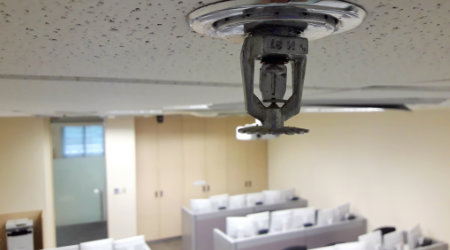How to Use Internet of Things Technology to Prevent Water Damage
Properly deploying and monitoring IoT devices and technologies can help mitigate risk and prevent millions of dollars in damage to commercial facilities.
Water damage is one of the most frequent and expensive property loss claims filed each year for commercial properties including office buildings, industrial complexes, retail outlets, mixed-use developments, and hotel properties. Unfortunately, over the past few years, water damage claims have increased in both frequency and severity. Water damage causes billions of dollars in financial losses across the real estate industry, and these claims can get extremely costly for businesses. Direct costs for cleanup, repairs, replacements, and mold remediation, as well as indirect costs, such as legal fees, delayed projects, or business interruptions, can wreak havoc on an organization’s profit and loss statement.
A major factor in how severe the water damage can get is the number of stories in a building. As the number of stories increase, severity increases. A water leak from a top floor in a high-rise building can flow down several stories undetected and cause extensive damage. This is happening more frequently and with extensive damage, and what’s more, the older and less-cared-for buildings can be subject to sudden and accidental water leaks due to exposed conditions going unnoticed.
In a recent water damage loss, a fire sprinkler line burst in the ceiling cavity on the 28th floor of a high-rise office building. Water flowed down six floors, getting into three elevator shafts, plus corridors and hallways. This resulted in more than $1.5 million of building and personal property damage for the property owner.
Although water damage can be costly, there are several strategies that real estate owners and property managers can employ to help prevent and mitigate it. This includes creating a written water damage prevention plan and leveraging technology, which can be implemented to help reduce water damage risks and costs.
Proactively Preventing Water Damage
Despite how common water damage is in the real estate industry, only a small percentage of businesses have a written water damage prevention plan. However, building owners and managers should create a plan because it is critical to preventing and mitigating water damage losses. Several items to keep in mind when designing a water damage prevention plan include establishing a team and providing training, outlining pre- and post-event job responsibilities, and identifying the location and properly label shut-off valves.
Real estate businesses should also enhance site inspection activities to include high-risk areas of potential water intrusion, identify water intrusion prevention and control measures, as well as establish post-event restoration and recovery strategies. In addition, they should identify and establish pre-event contracts with repair and remediation contractors and transfer risk contractually to responsible parties.
High-Risk Areas for Water Damage in Property
Finding areas at a high risk of water intrusion is one way to protect a business. Based on claim data from 2014 to 2020, approximately 75 percent of all real estate industry property losses are due to accidental discharge related to plumbing, HVAC systems, and appliances. Some areas that can be more prone to water intrusion include interior systems such as piping, sprinklers, equipment, and appliances. However, the building envelope, or the roof, walls, and floors, as well as the exterior exposures like landscaping, gutters and downspouts can also impact losses due to water damage.
Some advice for real estate owners and managers is to pay attention to any pipes that are frozen or have erosion when doing building maintenance and be mindful that if the building is newly constructed, leaks and intrusions can happen because of a poor-quality plumbing installation. Also, don't forget to regularly check the outside of the building and make sure there is no damage or deterioration that could lead to water entering the building.
Using Technology to Help Prevent Water Damage
Technology can monitor and alert business owners to water leaks or intrusions. Property managers can install these detection systems in a part of the facility that has had a history of water damage. If the system senses a leak, it can send an alert to a maintenance employee’s phone or computer to give them the chance to make necessary changes before the event turns into a costly claim. Water detection technology can also connect to control valves, so if there is a leak, the system can automatically shut off water to prevent any further damage.
One new strategy that is gaining momentum is to use Internet-of Things (IoT) technology to help reduce potential losses at commercial properties nationwide. Using state-of-the-art devices connected to a network, property managers and maintenance staff can collect, share, and act on information in real-time before a water event creates a costly issue. Some examples of the devices that can help prevent water damage include water sensors to detect the presence of water and send an email or text alert, as well as flow monitoring systems placed near a water meter to detect unexpected or unusual flows.
There are also automatic shut-off switches, which get triggered by a water sensor or flow monitor to stop inadvertent water flow, and temperature and humidity monitoring to detect potential mold conditions or identify potential freeze conditions before a pipe burst. For example, if a business installed water sensors and automatic shut-off valves and a pipe begins to leak, it will activate a water sensor, which can then trigger the automatic valve to shut off to prevent more water from leaking. At the same time, the maintenance staff or property owner can receive an alert through email or phone letting them know about the leak. The key is that with IoT devices, the technology is always on the job to help protect business owners from water damage and intrusion.
Robert Sullivan is the Real Estate Industry Practice Lead for The Hartford’s Middle and Large Commercial segment. With more than 30 years of underwriting experience, Rob specializes in the real estate, retail, restaurant, and hotel industry sectors. He leads a dedicated team of subject matter experts that are passionate about understanding industry trends and rapidly changing customer needs.
Related Topics:









